What Is A Groundbait Feeder?
Another phrase used is ‘open-ended feeder’ and that best describes what it is. Unlike a block-end feeder for maggot fishing, a groundbait feeder (usually) has both ends open and groundbait is used to carry the feed into the swim. As you can see on this page, there are many different types to suit various needs.
Cage feeders will allow the groundbait to leave the feeder on contact with the water, and are good for shallow swims and creating a cloud in the water. Those with no or few holes are better for deeper swims and rivers when you want the feeder to reach the bottom before releasing any feed.
When you need to cast a long way, feeders with a tapered lead attached are a great help – you won’t go far wrong if you use the Nisa flyers, but the finned versions also help you to cast true into a wind.
Accurate Casting
The whole idea when fishing the groundbait feeder is to create a tight area of food out of range of the pole.
In order to do this you need to make sure you are continually casting to the same mark so that the feeder hits the bottom in more or less the same place every time. You need to use the line clip on your reel to do this. Once you are happy with the distance, simply wrap the line around the clip on the reel’s spool before winding in. Then cast to the clip every time, ensuring the exact same distance. Don’t cast to your maximum distance before clipping up – be a little conservative, because if a wind gets up you won’t be able to cast as far as you’d like.
The other trick to keeping the feed tight is to pick a far bank marker (one which isn’t going to move!) and aim at this each time. You should soon get into a rhythm, and if you go wide of the mark simply reel straight in and cast again.
Sinking Arc
You also need to bear in mind the depth of the water you’re fishing. Once the line hits the clip, the feeder will sink in an arc towards you on a tight line, and if food is coming out as it does so it will scatter feed (and thus fish) over too wide an area.
While the feeder is firing out, draw the rod tip so that when the feeder hits the line clip the rod tip is behind you. Then move the tip forward as the feeder sinks, thus ensuring it goes in a straight line downwards. The feed will then be deposited in the required tight area.
Fishing For Bream
Bream and skimmers are the classic fish to target on the groundbait feeder on both rivers and large stillwaters. The only problem with feeder fishing for bream is that unless they are on one of those rare aggressive days they are notorious for backing away if there is any disturbance, such as another feeder full of bait landing on their heads.
On calmer days and in shallower water especially, it can often pay to switch to a bomb rather than a feeder so that less disturbance is caused.
Another good trick if the swim goes dead after a period of bites is to fish just beyond the feeder. Bream and skimmers often back off the area where the feeder sits by two or three metres. Just cast, take the line out of the line clip, measure off two or three arms’ lengths and clip up again. A lot of anglers will also mark the original position of the clip, with a marker pen, Tippex or with a tight sliding stop knot so they can quickly go back to fishing where the bait lays.
How Big A Feeder?
A lot of bream anglers start with a very large feeder which is only used for getting bait into the peg. The object of the exercise is to get the fish feeding on your hook bait, and some match anglers often spend up to 15 minutes at the start of the match continually casting large feeders full of bait to the same spot. This will certainly cause fish to back away. But, remember they are hungry so they won’t be far away.
A really good trick if you do this is to start fishing maybe three metres past the feed with a smaller feeder, and then gradually work your way back to where the main feed is. If your bites die off, switch back to a large feeder for a few casts to get more bait into the peg, and then clip back on the smaller feeder, which makes less disturbance.
Fishing With Braid
Braid mainline is not for the beginner, but when you’re fishing for skimmer bream, which can be incredibly shy biting, it can be a must. Normal mono lines offer plenty of stretch and often that means you don’t even see a delicate skimmer bite. Even with pre-stretched lines bites are often missed.
Braid has zero stretch and bites you don’t even see when fishing with mono are very obvious when fishing with braid. So why doesn’t everyone use it? Well, because it’s not easy to use. For a start you need a soft, through-actioned feeder rod or more often than not you will simply pull the hook out of the fish’s mouth – especially when you first connect with the bite, and when the fish is under the rod tip and nearing the net. In fact, you don’t strike at all with braid, you simply pick up the rod on a bite and start winding.
Braid Shockleaders
Most anglers use a mono shockleader at the end of the braid to act as a shock absorber both on the cast and when fish are under the rod tip; there should be enough mono so that, as you cast, there are at least five turns on the reel.
This can be attached in a number of ways. Use either a tucked half blood knot or a four-turn water knot – we’ll be showing you how to tie these in forthcoming issues.
The key if you use a shock leader is to leave the tags of the knot at least an inch long. If you trim them tight, the stub of line can all too easily catch in the thin top rod rings on the cast, and that will result in you cracking off the feeder. Another option is to use what’s called a ‘bungee’, and attach the braid to these directly – the bungee will stretch on the cast and should prevent hooked fish from coming off as you bring them in.
The main key to fishing with braid, however, is the rod you choose – it must have a soft, throughish action. Preston Innovations’ 11ft 6in CarbonActive Feeder is excellent with braid. With a stiff rod you will pull the hook out of the fish on the retrieve. There are many braids on the market but you won’t go far wrong with 4lb Berkley Fireline which, in our view, is the business. Another worth a look and which sinks well is the Drennan Feederbraid.
Sinking The Line
This is vital when feeder fishing on stillwaters. If the line is allowed to float it gets affected by surface tow and cross winds, and it’s impossible to see delicate bites register.
There are a few tips to help make line sink and the first is to use a mainline that’s marked sinking on the spool – good examples include Korum Reel Line, Ultima Power Plus and Daiwa Matchwinner. Whatever you use, treat it with a line sinkant before starting. You can buy these in spray form but just as good is a 50:50 mix of washing-up liquid and water. Just rub this well into the spool before you start and it should last a couple of hours.
To further aid the sinking process, after you’ve cast in, and just as the feeder is about to hit bottom, put the rod tip under the surface of the water and strike sharply upwards. This has the added bonus of jerking the feeder a touch and releasing some of the particles in a cloud near the bottom.
Setting Up
Four excellent groundbait feeder set-ups are shown below. Lines should obviously be chosen to match the species you are after, and how hard they fight, and whether or not you have to be aggressive to keep fish away from snags.
For bite registration, set the rod to the side so that the quivertip is only just off the water’s surface. Again this alleviates problems with tow and cross-winds.
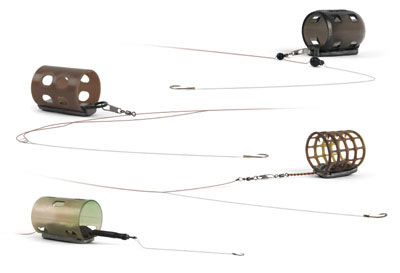
Fishing On Rivers
On drains and slow-moving rivers you should set up as described above for stillwaters, However, on fast-moving rivers the idea is to use as little weight as you can so the holds stationary on the bottom. To achieve this you need to have the rod tip high, thus bringing as much line as possible out of the flow. The more line that’s affected by the flow, the more weight you’ll need to hold. With the rod tip high you should pay out a bow of line as the feeder sinks after casting. This also allows you to use less weight to hold station than when fishing tight to the feeder. The whole idea is that when a fish picks up the weight, it dislodges the feeder and the tip bounces back on a slack line. There’s no need to strike as the fish will have hooked itself as the feeder moved downstream in the flow.
The exception is when fishing for powerful river fish like barbel. These will usually push over the tip in unmistakable fashion. Lovely!
Mixing Tips
Different fish respond to different types of mix. Roach, for instance, like to dart about picking up food as it sinks, and an active groundbait mix which breaks out of the feeder and sends particles up into the water is ideal. Groundbaits tagged as ‘explosive’ fit the bill perfectly, and you can aid the activity by mixing just before fishing and using certain dry additives in the groundbait, such as crushed hemp.
If you’re fishing for bream the requirements are completely different. Bream can back away from an active mix and it pays to fish a fine, inert groundbait. Some anglers mix up the groundbait the night before fishing so it’s really stiff, but be warned that in warmer weather groundbaits can ferment overnight and go sour.
Bream in England respond really well to fine fishmeal, even on most natural waterways, and a 50:50 mix of fishmeal and plain brown crumb, put together well before fishing and pushed through a pinkie riddle, should serve you well.
Riddling Your Groundbait
The reason for riddling groundbaits is to remove all the lumps you get when mixing so that it breaks down easily. But this can’t be done effectively through your hands. Fish are very partial to eating the groundbait and lumps will make a fish feel full, resulting in fewer catches. For coarse mixes a larger mesh groundbait riddle is needed; for finer mixes a pinkie riddle with smaller holes is better.
Fishmeal, in particular, soaks up a lot of water and it pays to over-wet it on the first wetting. Leave the groundbait for about half and hour, then riddle and add more water if you think it needs it. When the groundbait is right a light squeeze in one hand should hold it together, but it should crumble into fine particles very easily.
If mixing the night before store in a bucket with a towel over it or in one of the excellent zip-up groundbait bowls with carrying handles – and keep it cool! Even better, put the mixed and riddled groundbait into a plastic bag and seal. When you get to the venue just put it through a riddle once and you’re ready to go.
Should I Use Additives?
That’s up to you really. Certainly bream love fishmeal but there are anglers who swear by adding a sweet flavour in the summer months. Liquid molasses is one of the best and should be mixed into the water you use to mix your groundbait.
For roach, some continental anglers use vanilla and, as previously mentioned, adding crushed hemp to the groundbait enhances the activity.
Carp-wise you pays your money and takes your choice, although you’ll rarely go far wrong with something very fishy. A very good additive to groundbait in clear water is a fine powder called Sensas Tracix. Available in black, yellow and red, this is also best added to the water you use to mix your groundbait. It creates a fine, lingering cloud which is particularly good when targeting silver fish like skimmers as the fish feel safe in the cloud and feed more readily, just as they do when there’s colour in river water after rain.
Feeders
The tcf team picks out eight of the best open-ended feeders.
 |
Nisa Flyer
Tapered lead on the side of the feeder makes these flyers tcf’s number one choice for long range bream fishing or mastering windy conditions. We wouldn’t be without them. |
|
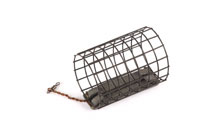 |
Metal Cage
Releases its contents quickly and is good for fishing in shallow water, especially when targeting carp close to features, such as an island. |
|
 |
Fox Finned
Comes in cage and solid versions, as well as in many different sizes, the largest being good for getting plenty of bait into your swim at the start. Interchangeable leads make them adaptable for many situations. The fins are designed to fly truly through the air and improve casting accuracy. |
|
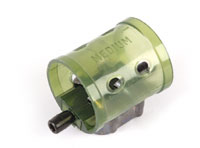 |
Inline
In situations where the fish will come to the feeder, these can be deadly when fished semi-fixed or, where that’s banned, as a running rig. We show you how to make your own on the following pages. |
|
 |
Daiwa Harrier
Unique design sees these rise swiftly up in the water on the retrieve so they are ideal for deep-water river situations and anywhere that shallows up steeply or has lots of snags on the bottom. |
|
 |
Drennan Gripmesh
Teeth inside the cage help contain the contents and these are ideal when feeding pellets or if you need to use a dryish groundbait mix. They come in dark blue or brown. |
|
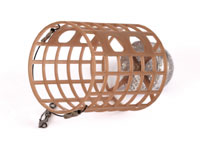 |
Nisa Rocket
When you want to fish a cage feeder at long range or in a strong wind, the Nisa Rocket will fly better than anything else on the market. The first versions of these we saw broke quite easily at the point where the bullet is attached, but we believe they have now been strengthened. |
|
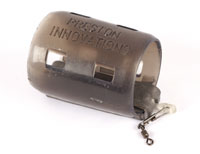 |
Preston Open-End Power Feeder
A very tough plastic open-end feeder available in a wide range of weights and sizes. Rim is slightly inturned to help contain the contents on the cast. Good on rivers. |
|
Accessories
 |
Bungees
Designed to let you fish direct with braid, these sit between the braid and the hooklength. Can be too cumbersome when shy-biting skimmers are the target, but good if bream are about and biting aggressively. |
|
 |
Strap Leads
Also known as ‘dead cows’, these weights are attached by folding the arms through the holes in the feeder, usually to help you just hold the bottom of the river. |
|
 |
Target Board
Lined board with a thread in the bottom to attach to a bank stick. You line up the tip with these, and they help you distinguish small movements of the quivertip when fish such as skimmers are only giving shy bites. |
|
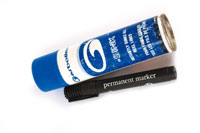 |
Line Sinkant
Spray this onto the spool before you start fishing and the line will sink quickly under a tight line so you are working effectively straight away. You can make your own with a 50:50 mix of washing-up liquid and water, which you simply rub into the spool. |
|
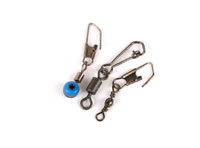 |
Snap Swivel
The most common way of connecting your feeder to your set-up, with the swivel end fished free-running on the mainline or in a loop, and the ‘snap’ end allowing a quick change to a different-sized feeder or bomb. |
|
 |
Enterprise Adjusta Stop
Clever little accessory that allows you to fish your mainline straight through to the hook while quickly and easily altering the distance the running feeder sits above the hook. |
|
 |
Powergum
Used to create a shock-absorbing link between the feeder and swivel through which your mainline goes. |
|
 |
Electrical Tape
Useful for covering up the holes when you want the feeder to hit the bottom before it releases any of its contents. |
|
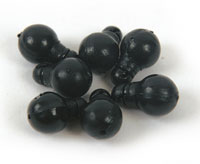 |
Korum Change Bead
Lightweight accessory that allows you to quickly change hooklengths without having to continuously snap off the line. |
|
|

























